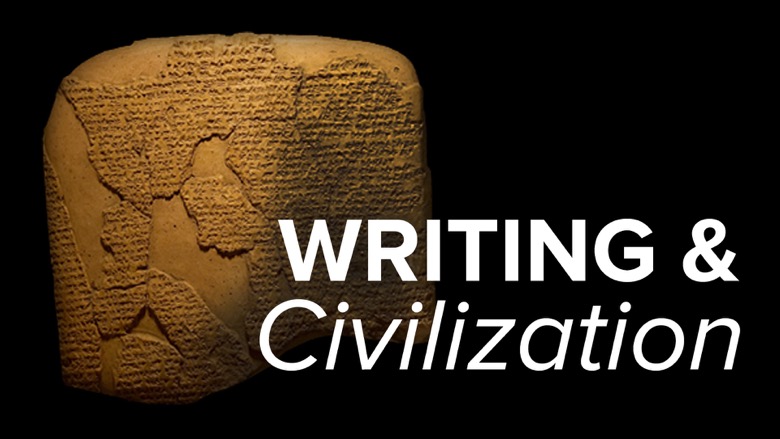

Professor Marc Zender – whisks you around the globe on a thrilling journey to explore how an array of sophisticated writing systems developed…


The invention and development of writing is a fascinating subject; it sheds light on human ingenuity, complexity, and even on civilization itself.
Institution: Ph.D., University of Calgary
Alma mater: Tulane University
Can you imagine the world—or your life—without writing? From emails to street signs and newspapers to novels, the written word is so ever-present that we rarely stop to consider how it came to be.
Yet at just over 5,000 years old, writing is actually a relatively recent invention. It has become so central to the way we communicate and live, however, that it often seems as if writing has always existed.
Through writing, we gain knowledge about past cultures and languages we couldn’t possibly obtain any other way. Writing creates a continuous historical record—something an oral history could never achieve. And writing systems are integral to many cultural identities and serve as both a tool and a product of many important societal structures, from religion to politics.
The fundamental role and impact of writing in our civilization simply cannot be overstated. But the question remains: Who invented writing, and why?
Like any event from our prehistoric past, the story of writing’s origins is burdened by myths, mysteries, and misinformation. For the past two centuries, however, dedicated scholars have used rigorous methods to uncover a tale of intrigue, fascinating connections, and elegant solutions to the complex problem of turning language into text.
In the 24 visually intensive lectures of Writing and Civilization: From Ancient Worlds to Modernity, you’ll trace the remarkable saga of the invention and evolution of “visible speech,” from its earliest origins to its future in the digital age. Professor Marc Zender—Visiting Assistant Professor of Anthropology at Tulane University and an accomplished epigrapher—whisks you around the globe on a thrilling journey to explore how an array of sophisticated writing systems developed, then were adopted and adapted by surrounding cultures.
This course answers many of the most common questions about the world’s writing systems and the civilizations that created them, plus a number of questions you may never have thought to ask.
Along the way, you’ll visit the great early civilizations of Egypt, Mesopotamia, China, Japan, and the Americas, and you’ll see how deciphering ancient scripts is a little like cracking secret codes—only far more difficult.
Witness the Triumphs of Decipherment
Through the process of decipherment, civilizations including Egypt, Mesopotamia, Crete, and Mexico have, as Professor Zender says, “all given up their secrets.” Lost histories, literatures, and religions can now be studied in translation, and the disciplines of ancient history, archaeology, and comparative literature have benefited enormously as a result.
You’ll be spellbound as you hear accounts of the breathtaking moments when the decipherment of ancient scripts broke centuries of silence. And you’ll marvel at fascinating objects once shrouded in mystery, including
Crucial to your understanding of how epigraphers decipher scripts—and why they’re sometimes unsuccessful—are five preconditions known as the “pillars of decipherment,” which you’ll study in detail and return to throughout the course.
A Window into the Past
Among the fascinating takeaways from studying lost scripts is a newfound sense of shared humanity with ancient peoples. The cuneiform scripts of ancient Mesopotamia, Anatolia, and Persia, in particular, are eerily modern and reveal glimpses of the origins of practices and beliefs that continue to the present.
You’ll also see how writing was used for political purposes by our earliest civilizations, as in the practice known as damnatio memoriae, whereby ousted leaders were quite literally erased from history, either through the recarving of inscriptions or by omission from official records. Ironically, it is Tutankhamen’s own erasure that may have helped obscure his tomb from raiders.
Despite the obvious connection between language and writing, this course draws a clear distinction, explaining how single languages can be written using various writing systems. English, you’ll learn, was once written with runes. In antiquity, Greek was represented by at least three different scripts.
In exploring how writing systems rise and fall, you’ll encounter many scripts that are associated with languages that have surviving descendents, including those of the Akkadians, Babylonians, and Assyrians, which have relatives in Hebrew and Arabic. Others scripts you’ll study—such as those of the Elamites, Hurrians, and Sumerians—record languages that have died out or evolved to the point of being unrecognizable.
Myths Dispelled, Revelations Told
In Writing and Civilization, you’ll encounter a wealth of eye-opening information that sets the record straight on this enigmatic subject. Here are just a few of the misconceptions that you’ll encounter and investigate in greater detail.
You may also be surprised to learn that the Aztecs possessed writing, and that unearthed Aegean writings in Linear B spoke only of mundane accounting matters rather than Theseus and the Minotaur and Icarus, as early scholars predicted.
Hear Messages of the Ancients Revealed
Writing and Civilization offers lifelong learners the chance to not only discover the history of ancient writing systems, but also the rare opportunity to actually hear those scripts read aloud and to learn the meaning of their messages hidden in plain sight.
As an expert on Mesoamerican languages and writing systems and an international lecturer on decipherment, Professor Zender has conducted linguistic, epigraphic, and archaeological fieldwork in much of the Maya area, including Belize, Guatemala, Honduras, and Mexico. His expertise, along with firsthand accounts of his experiences and discoveries, adds an invaluable perspective that truly brings this riveting material to life.
You will also be captivated by the extraordinary visuals accompanying each dynamic lecture, including photographs of ancient sites and artifacts, explanatory animations, and numerous illustrations artfully drawn by the professor—many exclusively for this course.
From papyrus to personal computer, the story of writing is 5,000 years in the making, and it’s still evolving. Investigate the fascinating relationships between language and writing, and the cultures that gave birth to them, in Writing and Civilization: From Ancient Worlds to Modernity.
There are no reviews yet.
You must be <a href="https://wislibrary.org/my-account/">logged in</a> to post a review.